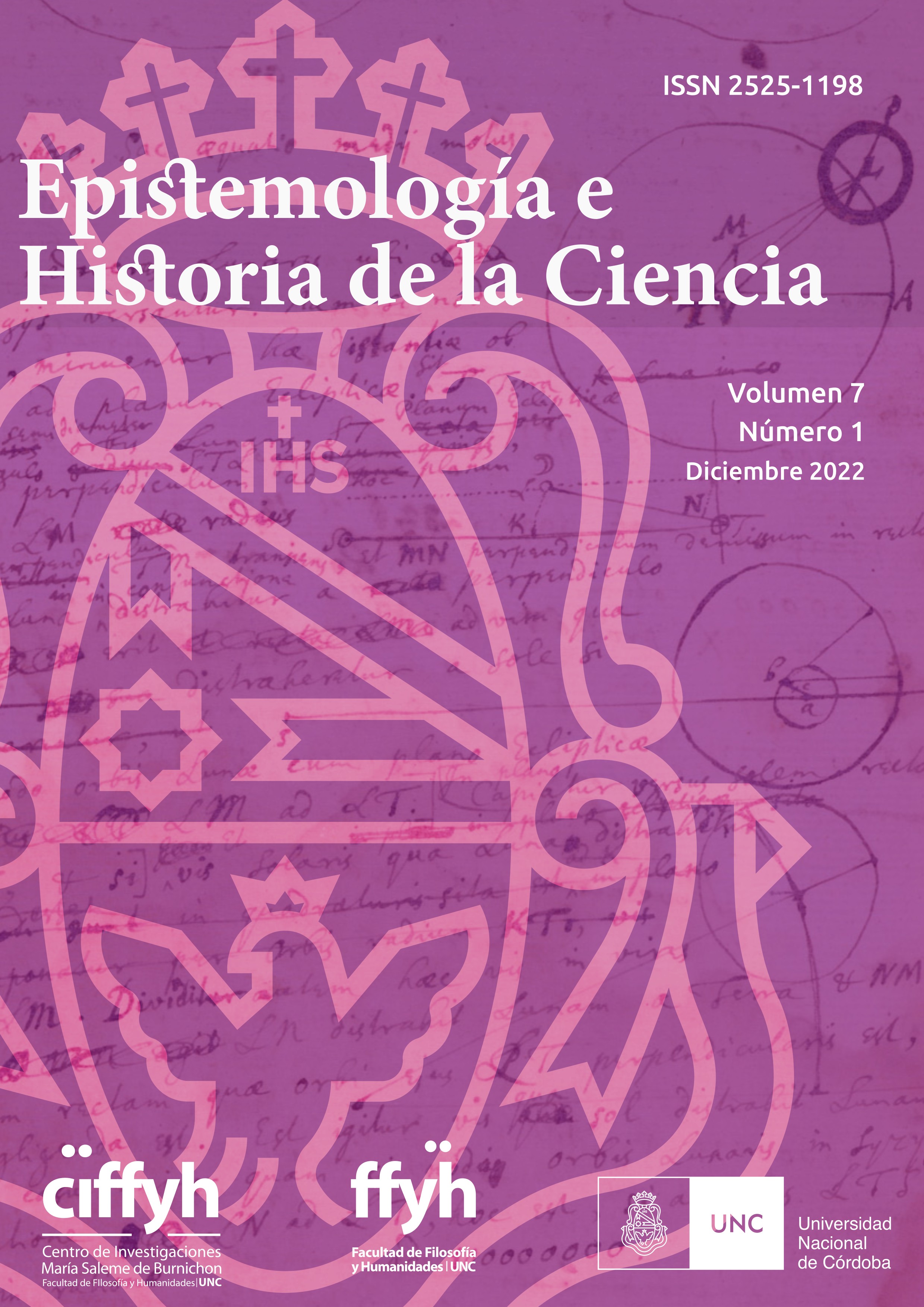Formal equivalence in the language of McCulloch’s and Pitts’ logical neurons
Keywords:
formal equivalence, logical neurons, new mechanism, scientific modelsAbstract
In this article we consider the significance of formal equivalence in the language proposed by Warren McCulloch and Walter Pitts in their original “A logical calculus of the ideas immanent in nervous activity”. We study the model from the contributions that it has meant in the history of science: as a computational theory of mind; and as a formalism that contributed to the development of automata theory and logical design. This question is framed into the mechanistic explanation account and the philosophy of scientific models, while also attending to how the model embedded a conception of a language as a logical calculus. We consider the relationship between the model and its target system, offering two possible interpretations: logical neurons are the model that represents the mind-brain or it is a new conceptual object that enables the development of artificial automata. We observe how the formal equivalence notion plays a fundamental role: as scientific explanation about mind’s theory, as an isomorphism criterion of mind’s model, and as identity criterion of logic neurons or formal neurons.
References
Abraham, T. H. (2002). (Physio)Logical Circuits: The intellectual origins of the McCulloch-Pitts Neural Networks. Journal of the History of the Behavioral Sciences, 38 (1), 3–25. https://doi.org/10.1002/jhbs.1094
Arbib, M. (1987). Brains, machines and mathematics. Springer Verlag.
Barberis, S. (en prensa). La explicación mecanicista. En prensa.
Branca, M. I., Ramírez, A. O., y Vilatta, M. E. (2015). Modelos de explicación en psicología cognitiva y neurociencias. Anuario de Investigaciones de la Facultad de Psicología, 2 (1), 176-191. https://www.revistas.unc.edu.ar/index.php/aifp
Boolos, G., Burgess, J., Jeffrey, R. (2007). Computability and Logic. Cambridge University Press.
Carnap, R. ([1937] 2007). Logical Syntax of Language. Routledge.
Cassini, A. (2018). Models without a Target. Artefactos. Revista de estudios de la ciencia y la tecnología. 7 (2), 185-209. http://dx.doi.org/10.14201/art201872185209
Craver, C. (2007). Explaining the Brain. Mechanisms and the Mosaic Unity of Neuroscience. Oxford, Clarendon Press.
Dupuy, J-P. (2000). The mechanization of the mind: On the origins of cognitive science. Princeton University Press.
Fitch, F. (1944). Review of McCulloch and Pitts 1943. Journal of Symbolic Logic. 9 (2), 49–50. https://doi.org/10.2307/2268029
Householder, A. (1941a). A theory of steady-state activity in nerve-fiber networks: I. Definitions and preliminary lemmas. Bulletin of Mathematical Biophysics, 3, 63–69. https://doi.org/10.1007/BF02478220
Householder, A. (1941b). A theory of steady-state activity in nerve-fiber networks II: The simple circuit. Bulletin of Mathematical Biophysics, 3, 105–112. https://doi.org/10.1007/BF02478168
Householder, A. (1941c). A theory of steady-state activity in nerve-fiber networks III: The simple circuit in complete activity. Bulletin of Mathematical Biophysics, 3, 137–140. https://doi.org/10.1007/BF02477933
Householder, A. (1942). A theory of steady-state activity in nerve-fiber networks IV: N circuits with a common synapse. Bulletin of Mathematical Biophysics, 4, 7–14. https://doi.org/10.1007/BF02477350
Kleene, S. C. (1956), Representation of Events in Nerve Nets and Finite Automata en C. E. Shannon y J. McCarthy (Eds.), Automata Studies, (3-42). Princeton University Press.
Lawvere, F. W. & Schanuel, S. (1997). Conceptual Mathematics: A First Introduction to Categories. Cambridge University Press.
(McCulloch & Pitts, 1943) McCulloch, W., & Pitts, W. (1943). A logical calculus of the ideas immanent in nervous activity. The Bulletin of Mathematical Biophysics, 5(4), 115-133. https://doi.org/10/djsbj6
McCulloch, W. y Pitts, W. (1990). A logical calculus of de ideas immanent in nervous activity. Bulletin of Mathematical Biology, 52 (l/2), 99-115. (Obra original de 1943) https://doi.org/10.1007/BF02459570
Northrop, F. S. C. (1931). Science and first principles. Macmillan.
Perkel, D. (1988). Logical neurons: the enigmatic legacy of Warren McCulloch. Trends in Neurosciences, 11 (1), 9-12. https://doi.org/10.1016/0166-2236(88)90041-0
Piccinini, G. (2003). Computations and computers in the sciences of mind and brain. [Tesis de doctorado, Universidad de Pittsburgh].
Piccinini, G. (2004). The first computational theory of mind and brain: a close look at McCulloch and Pitts’ “Logical calculus of de ideas immanent in nervous activity”. Synthese, 141, 175–215. https://doi.org/10.1023/B:SYNT.0000043018.52445.3e
Potochnik, A., Colombo, M., Wright, C. (2019). Recipes for Science. An Introduction to Scientific Methods and Reasoning. Editorial Routledge.
Schlatter, M. y Aizawa, K. (2008). Walter Pitts and “A Logical Calculus”. Synthese, 162, 235–250. https://doi.org/10.1007/s11229-007-9182-9
von Neumann, J. (1945). First Draft of a Report on the EDVAC. Technical Report, Moore School of Electrical Engineering, University of Pennsylvania. En línea: http://abelgo.cn/cs101/papers/Neumann.pdf
von Neumann, J. (1951). The General and Logical Theory of Automata. En L. A. Jeffress (Ed.), Cerebral Mechanisms in Behavior (pp. 1–41). Wiley.
Turing, A. (1936). On Computable Numbers, with an Application to the Entscheidungsproblem. Proceedings of the London Mathematical Society, 42(1), 230-265. En línea: https://www.cs.virginia.edu/~robins/Turing_Paper_1936.pdf
Zamora-Cárdenas, W., Zumbado, M., Trejos-Zelaya (2020). McCulloch-Pitts Artificial Neuron and Rosenblatt's Perceptron: An abstract specification in Z. Revista Technology inside by CPIC, 5 (5), 16-29. https://cpic-sistemas.or.cr/revista/index.php/technology-inside/article/view/36/27
Downloads
Published
Issue
Section
License
Copyright (c) 2022 Rocío Stefanazzi Kondolf

This work is licensed under a Creative Commons Attribution-NonCommercial-NoDerivatives 4.0 International License.
En todos los lugares donde aplique, esta obra está bajo una licencia Creative Commons Reconocimiento-NoComercial-SinObrasDerivadas 4.0 .
- Los autores/as conservarán sus derechos de autor y garantizarán a la revista el derecho de primera publicación de su obra, el cual estará simultáneamente sujeto a la Licencia de reconocimiento de Creative Commons que permite a terceros compartir la obra, siempre que se indique su autor y su primera publicación en esta revista.
- Los autores/as podrán adoptar otros acuerdos de licencia no exclusiva de distribución de la versión de la obra publicada (p. ej.: depositarla en un archivo digital institucional o publicarla en un volumen monográfico), siempre que se indique la publicación inicial en esta revista.
- Se permite y recomienda a los autores/as difundir su obra a través de Internet (p. ej.: en archivos digitales institucionales o en su página web) antes y durante el proceso de envío.
- Las licencias de las imágenes de terceros incluidas en los artículos pueden estar sujetas a otros términos; los autores/as son responsables de asegurar la veracidad de su origen, la información de la fuente original provista y su permiso de reproducción en esta publicación, que puede ser exclusivo.







